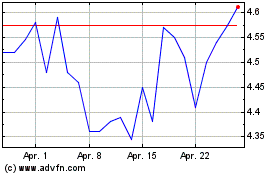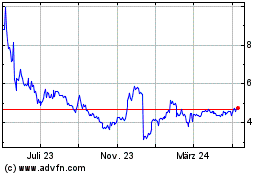Achieve Life Sciences Announces Patent Granted by USPTO for New Cytisinicline Formulation
21 Dezember 2022 - 2:00PM

Achieve Life Sciences, Inc. (NASDAQ: ACHV), a clinical-stage
pharmaceutical company committed to the global development and
commercialization of cytisinicline for smoking cessation and
nicotine dependence, today announced that the United States Patent
and Trademark Office (USPTO) has issued U.S. Patent No. 11,459,328
covering the mesylate salt formulation of cytisinicline and the
process for its development.
“Continuing to expand our intellectual patent
portfolio around cytisinicline further protects our nicotine
dependence franchise,” commented John Bencich, Chief Executive
Officer of Achieve. “Including this latest issuance, our family of
patents protecting cytisinicline is now 18, including exclusivity
until 2040 for the novel 3.0 mg, three-times daily dosing regimen
that has been shown to be effective and very well-tolerated in our
Phase 3 clinical development program.”
Cytisinicline is a plant-based alkaloid with a high binding
affinity to the nicotinic acetylcholine receptor. Achieve continues
to pursue numerous patents that will further enhance the product’s
stability and the potential for life cycle expansion via varying
methods of administration.
Achieve is currently conducting the final FDA-registration
enabling Phase 3 ORCA-3 trial for smoking cessation and the Phase 2
ORCA-V1 trial evaluating cytisinicline for e-cigarette cessation.
The Company continues to expect topline data results for both
trials to be announced in the second quarter of 2023. For more
information on Achieve Life Sciences and cytisinicline please visit
www.achievelifesciences.com.
About Achieve and Cytisinicline Achieve’s focus
is to address the global smoking health and nicotine addiction
epidemic through the development and commercialization of
cytisinicline. Tobacco use is currently the leading cause of
preventable death that is responsible for more than eight million
deaths worldwide and nearly half a million deaths in the United
States annually.1,2 More than 87% of lung cancer deaths, 61% of all
pulmonary disease deaths, and 32% of all deaths from coronary heart
disease are attributable to smoking and exposure to secondhand
smoke.2
In addition, there are nearly 11 million adults in the United
States who use e-cigarettes, also known as vaping.3 While nicotine
e-cigarettes are thought to be less harmful than combustible
cigarettes, they remain addictive and can deliver harmful chemicals
which can cause lung injury or cardiovascular disease.4 In 2021,
e-cigarettes were the most commonly used tobacco product reported
by 1.72 million high school students.5 Research shows adolescents
who have used e-cigarettes are seven times more likely to become
smokers one year later compared to those who have never vaped.6
Currently, there are no FDA-approved treatments indicated
specifically as an aid to nicotine e-cigarette cessation.
Cytisinicline is a plant-based alkaloid with a high binding
affinity to the nicotinic acetylcholine receptor. It is believed to
aid in treating nicotine addiction for smoking and e-cigarette
cessation by interacting with nicotine receptors in the brain,
reducing the severity of withdrawal symptoms, and reducing the
reward and satisfaction associated with nicotine products.
Cytisinicline is an investigational product candidate being
developed for treatment of nicotine addiction and has not been
approved by the Food and Drug Administration for any indication in
the United States. For more information on cytisinicline and
Achieve visit www.achievelifesciences.com.
Forward Looking StatementsThis press release
contains forward-looking statements within the meaning of the “safe
harbor” provisions of the Private Securities Litigation Reform Act
of 1995, including, but not limited to, statements regarding the
timing and nature of cytisinicline clinical development, data
results and commercialization activities, the potential market size
for cytisinicline, the potential benefits, safety and tolerability
of cytisinicline, the ability to discover and develop new uses for
cytisinicline, including but not limited to as an e-cigarette
cessation product, and the development and effectiveness of new
treatments. All statements other than statements of historical fact
are statements that could be deemed forward-looking statements.
Achieve may not actually achieve its plans or product development
goals in a timely manner, if at all, or otherwise carry out its
intentions or meet its expectations or projections disclosed in
these forward-looking statements. These statements are based on
management’s current expectations and beliefs and are subject to a
number of risks, uncertainties and assumptions that could cause
actual results to differ materially from those described in the
forward-looking statements, including, among others, the risk that
cytisinicline may not demonstrate the hypothesized or expected
benefits; the risk that Achieve may not be able to obtain
additional financing to fund the development of cytisinicline; the
risk that cytisinicline will not receive regulatory approval or be
successfully commercialized; the risk that new developments in the
smoking cessation landscape require changes in business strategy or
clinical development plans; the risk that Achieve’s intellectual
property may not be adequately protected; general business and
economic conditions; risks related to the impact on our business of
the COVID-19 pandemic or similar public health crises and the other
factors described in the risk factors set forth in Achieve’s
filings with the Securities and Exchange Commission from time to
time, including Achieve’s Annual Reports on Form 10-K and Quarterly
Reports on Form 10-Q. Achieve undertakes no obligation to update
the forward-looking statements contained herein or to reflect
events or circumstances occurring after the date hereof, other than
as may be required by applicable.
Investor Relations ContactRich
Cockrellachv@cg.capital(404) 736-3838
Media ContactGlenn
SilverGlenn.Silver@Finnpartners.com(646) 871-8485
References1World Health Organization. WHO
Report on the Global Tobacco Epidemic, 2019. Geneva: World Health
Organization, 2017.2U.S. Department of Health and Human Services.
The Health Consequences of Smoking – 50 Years of Progress. A Report
of the Surgeon General, 2014.3Cornelius ME, Wang TW, Jamal A,
Loretan CG, Neff LJ. Tobacco Product Use Among Adults — United
States, 2019. MMWR Morb Mortal Wkly Rep 2020;69:1736–1742. DOI:
10.15585/mmwr.mm6946a44Ogunwale, Mumiye A et al. (2017) Aldehyde
Detection in Electronic Cigarette Aerosols. ACS omega 2(3):
1207-1214. DOI: 10.1021/acsomega.6b00489].5Gentzke AS, Wang TW,
Cornelius M, et al. Tobacco Product Use and Associated Factors
Among Middle and High School Students – National Youth Tobacco
Survey, United States, 2021. MMWR Surveill Summ 2022;71(no.
SS-5):1-29. DOI: 10.15585/mmwr.ss7105a1.6Elizabeth C. Hair, Alexis
A. Barton, Siobhan N. Perks, Jennifer Kreslake, Haijun Xiao,
Lindsay Pitzer, Adam M. Leventhal, Donna M. Vallone, Association
between e-cigarette use and future combustible cigarette use:
Evidence from a prospective cohort of youth and young adults,
2017–2019, Addictive Behaviors, Volume 112, 2021, 106593, ISSN
0306-4603. DOI: 10.1016/j.addbeh.2020.106593.
Achieve Life Sciences (NASDAQ:ACHV)
Historical Stock Chart
Von Mär 2024 bis Apr 2024

Achieve Life Sciences (NASDAQ:ACHV)
Historical Stock Chart
Von Apr 2023 bis Apr 2024
